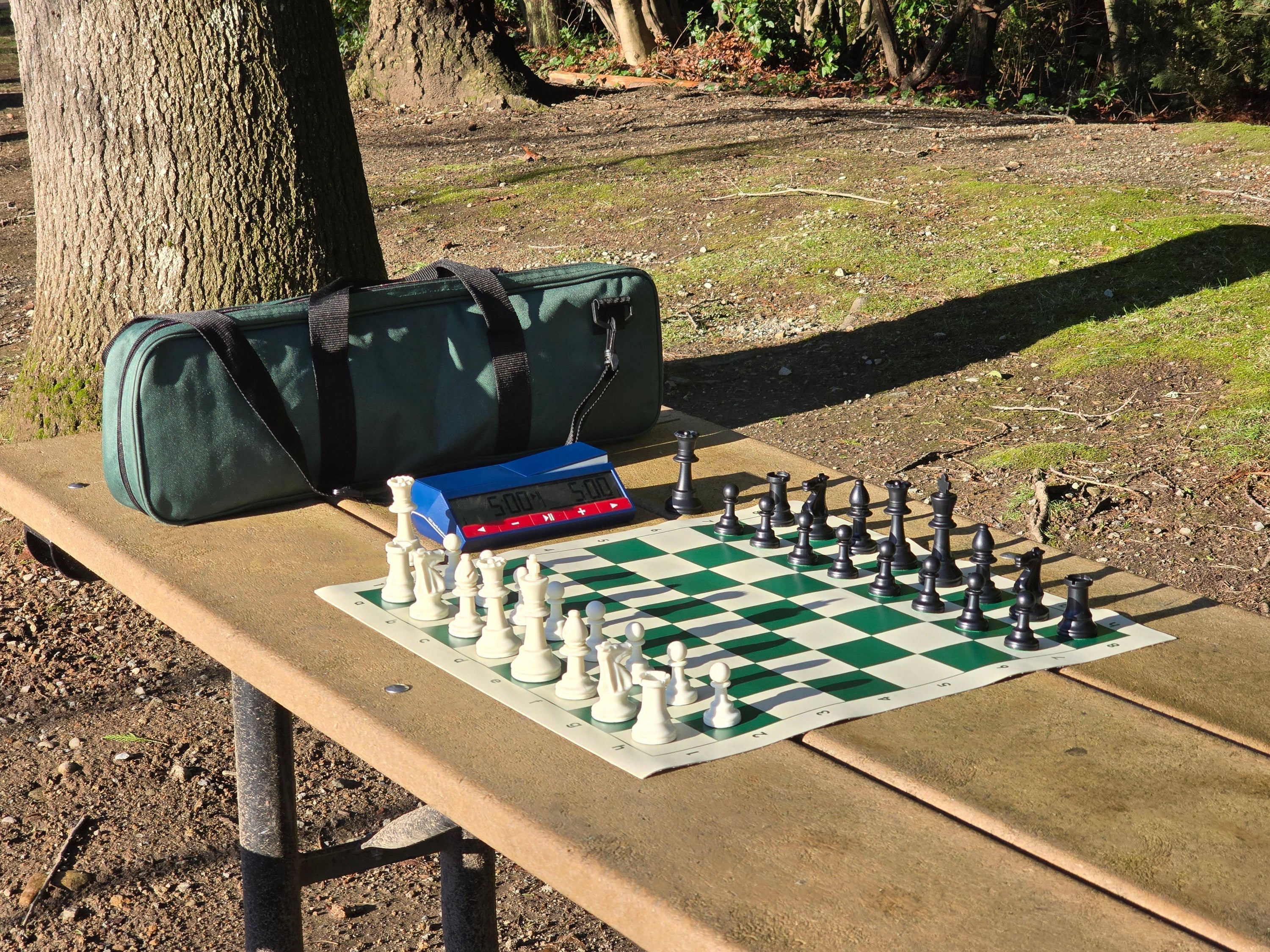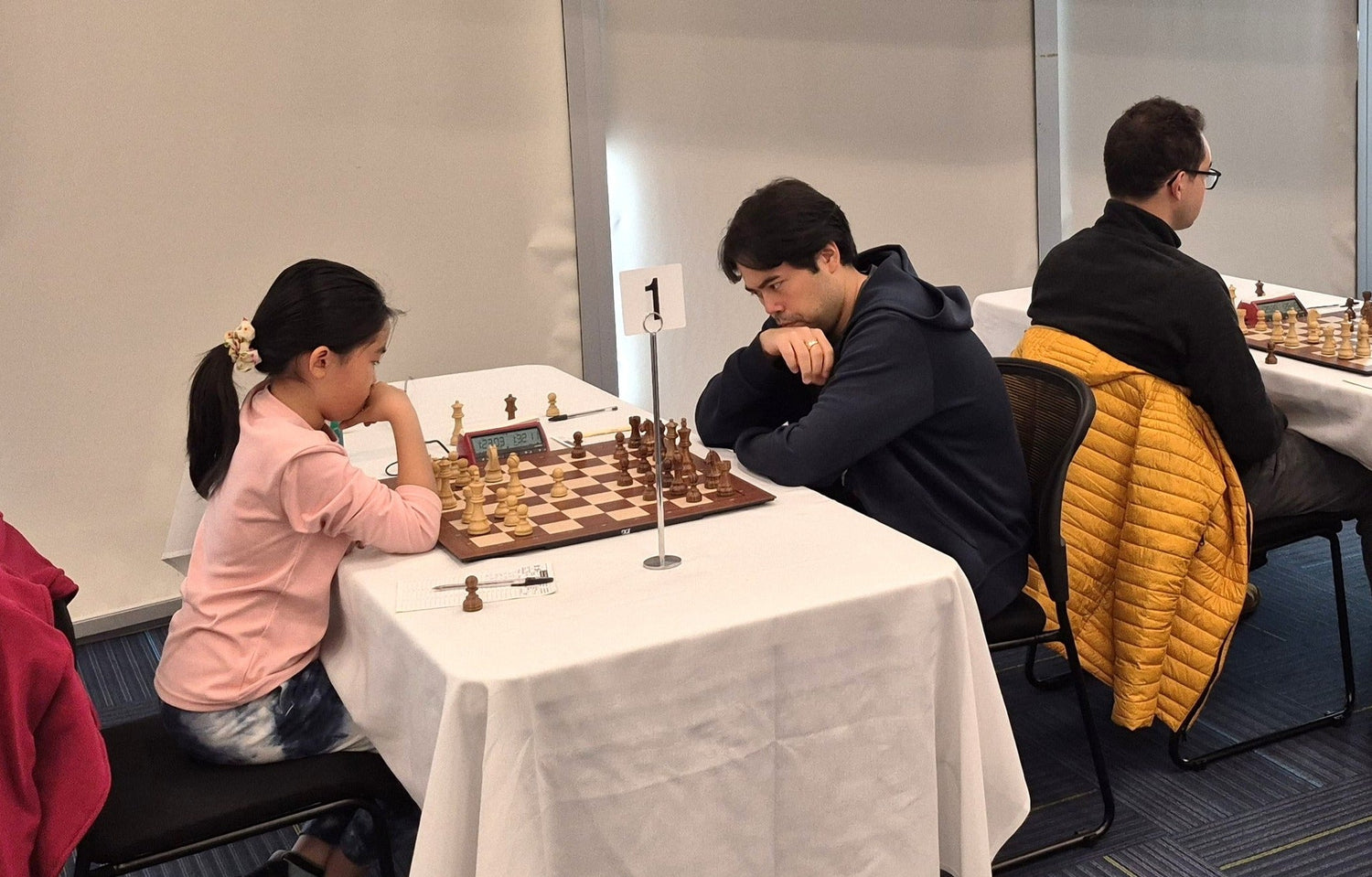Whether you’re just starting out and learning how to play chess or you’re getting back into the game after a long break, having a good, quality and affordable set will make your Over-The-Board (OTB) experience that much more enjoyable!
There are SOOO many options out there, and really—it’s quite overwhelming! So, I’m going to give a quick explanation regarding what to look for. If you want all the nitty gritty details, I’d recommend this article on chess.com https://www.chess.com/article/view/chess-board-dimensions.
What kind of chess set should I be looking for? Personally, I would recommend a set that is comparable to the standard United States Chess Federation (USCF) tournament set which has 2.25-inch squares and a king height of 3.75 inches with plastic pieces. This is the most common set that you will see used in tournament play in both Canada and the USA and is an excellent size for both adults and kids.
What’s the difference between vinyl, silicone, and mousepad boards? Silicone is easy to clean and retains its shape very well even after you crinkle it or fold it up tightly. However, the disadvantage is that pieces don’t slide as well on it and it can rip off the felt on the bottom of your chess pieces. This makes it problematic for playing blitz chess. Vinyl is very easy to clean and the pieces slide smoothly on it, however, if you don’t fold vinyl properly or crinkle it, it takes some time to get back to its original, flat condition. This problem can be mitigated by storing a vinyl board in a proper carrying case. Mousepad is a newer material and is a compromise between the two. Folds almost as well as silicone and the pieces slide almost as well as vinyl. However, they don’t clean as easily. I recommend vinyl chess boards.
What’s the difference between wood, silicone, and plastic pieces? Wood pieces have a nice feel but are usually more expensive and I find are more easily damaged by children. Silicon pieces can be bent, thrown, and are virtually indestructible! However, they don’t have the rigidity of plastic pieces. Plastic pieces are the most common and also very durable. I have sets that are over 25 years old! These are the standard pieces used in tournament play. I recommend plastic pieces.
What colour board should I get? Regulation green and white (buff) is standard, however, other colours such as blue, red, orange, purple, are also available. Whatever you enjoy looking at is what I would pick. However, if you really want to have something that looks as much like a tournament set as possible I’d go with the standard. I recommend a green and white (buff).
What’s the difference between single-weight and triple-weight pieces? Plastic pieces are light and prone to toppling over. Therefore, pieces usually have lead/metal weights inserted into them to give them a better feel. The standard tournament sets are single-weighted with the king weighing approximately 30 grams. The king in a triple-weighted set weighs just over 50 grams. This may not seem like a lot, however, the difference is noticeable when you pick up the pieces. Single-weight pieces are slightly cheaper but have the disadvantage of being unstable and falling over more often, especially when you’re playing fast. In long classical games where moving quickly is not as important, single vs triple-weighting doesn’t really matter. However, as blitz and rapid games are now very popular, having stable pieces that do not fall over is critical. In blitz games, knocking over pieces and having to reset them constantly can be the difference between winning and losing on the clock. I recommend triple-weighted black & white pieces.
What kind of carrying case should I get? There are many different options available for transporting your pieces. If you’re comfortable with an elastic band for your board and an ice cream bucket for your pieces, you don’t need to buy anything else! However, if you play a lot, it’s far easier to store everything in a solid bag that will make it easy for you to grab and go when you want to play! Regarding options, there are several:
1) A Mailing/Storage Tube – 3" x 24" – You can often purchase these at an office stationary store or your local post office for around $5. The advantage of this is that it is hard, cheap, and very easy to use. The disadvantage is that it can be damaged by water, stomped on, or destroyed.
2) Quiver – This looks like a quiver for arrows. It has handles and a shoulder strap and is very easy for children to sling. As they are not rigid, they aren’t easily destroyed and are often water-resistant. The disadvantage is that it can’t hold a clock well.
3) Deluxe Bag – These bags hold a rolled-up board in between two loops and contain two separate compartments to store white and black pieces. In the middle is a zippered pouch for a chess clock. The whole thing then zips up and can be carried by the handles or via a shoulder strap. As this kind of bag can carry a chess clock and conveniently separates pieces for quicker setup, I recommend the deluxe bag.
Should I buy a chess clock and what kind should I get? If you play frequently and enjoy fast-paced blitz and rapid time controls, I would highly recommend acquiring a good chess clock. A good, modern clock should have an easy to see LCD/display, the ability to add a time increment after each move, and support at least two time controls. In addition, time management is a critical part of playing a good game of chess and having a good clock is just a pleasure to use. It’s incredibly fun to just tap that lever, feel it slide down, and to know that you’re draining your opponent’s time bank! Now there are many different kinds of chess clocks, but I’m just going to list a few.
1) Smartphone/iPad – Simply download a chess timer app and put it on a phone and away you go for free. The downside is that you have to sacrifice your phone and phones lack the nice tactile feedback of a real clock. iPads also work, however, they’re a bit large and unwieldy.
2) Analog Clocks – These clocks do not require batteries but are completely mechanical and driven by springs and gears. In the days before digital clocks, I grew up playing with these and loved the satisfying click of the metal buttons, the wooden finish, and the movement of the hour and minute hands. The downside to these is that these clocks can be easily broken by children by overwinding them, dropping them, etc. Also, it’s hard to know how many seconds you have left in blitz games due to the lack of a digital display.
3) ZMF-II Digital Chess Clock – Made of a very tough plastic with stainless steel buttons. Buy this if you’re worried about damage.
4) Wholesale Chess Basic Digital Game Timer with Bonus & Delay – Cheap and basic clock. If you don’t want to spend much, just get one of these. Has basic support for bonus time/delay.
5) DGT NA (North American) – If you live/compete in North America, this is the clock that you’ll see most often at tournaments. It comes with many standard preset time controls like 5/0 (5 minutes with no increment), 3/2 (3 minutes with 2 second increment per move), 5/2, etc. It also allows for multiple time controls that are often seen in classical tournaments, i.e. 2 hours for the first 40 movies, and then 60/5 for the next 20 moves. This clock is very easy to use and can be used for bullet, blitz, rapid and classical games. If you’re serious about playing regularly, I would recommend this clock.
6) DGT 3000 – One of the best digital clocks you can purchase and designed to connect with a DGT smart e-chessboard. Overkill unless you’re very serious about the game and playing at a level that would require a connection to an e-board.





